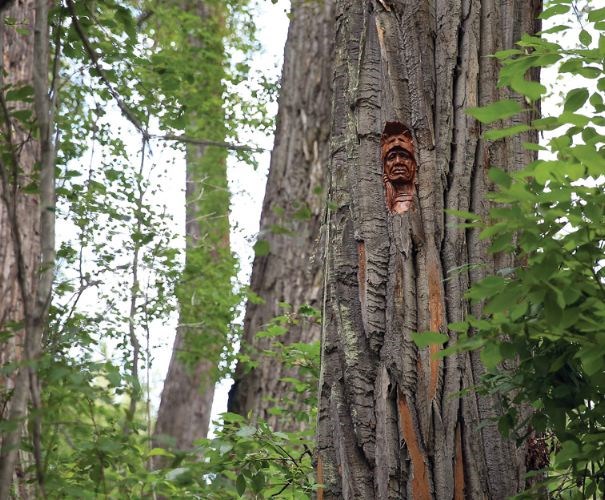Look up.
Way up.
And gaze upon the hidden treasures at Cottonwood Island Park where carver Elmer Gunderson has bestowed upon the bark of a few select trees images of a host of characters and wee fairy houses for the whimsical enjoyment of all who pass.
It's crossed the mind of many a tree lover to wonder if there is any harm done to these long-standing keepers of nature who have been honoured with a carving.
Kathy Lewis, forest pathologist at the University of Northern B.C., set the record straight.
"Cottonwood tends to have fairly thick bark, especially older trees, and as long as the cuts are only in the outer bark it really should not affect the tree at all," said Lewis. "The outer bark tissue is essentially dead but it is a protective covering for the tree. It's a first line of defence against attack by pathogens or insects and so long as that outer bark is the only part that's carved into it really shouldn't have much affect on the tree at all."
If the carver's cuts go too deep, it's a whole other story.
The inner bark of a tree is called the phloem, which is a living part of the tree tissue that transports water from the root up into the crown. Further into the tree is the wood tissue called the xylem.
"So if a cut penetrates into the inner living bark where the phloem is then it can create a place for decay fungi to take hold or it can cause the tree to release compounds that are defence responses that actually can attract insects to it," said Lewis. "So the picture changes quite a bit if it goes from that outer bark into the living inner bark."
Trees are well adapted to protecting themselves against things attacking them whether it's an insect that's trying to chew its way into the tree or a decay fungus, she added.
"As long as that exposure of the inner bark isn't very large, trees are usually able to mobilize defence compounds and resins and those kinds of things and wall off that area to protect the rest of the tree from further invasion," said Lewis.
With cottonwood, the bark can be thick, reaching between five to eight centimetres, especially at the base of the tree and in mature trees, added Lewis.
The transition between the outside bark and the inner bark is quite noticeable.
"Especially in the spring that's when the trees are actively producing sap and if you cut into that you'll notice because the tree will start bleeding, essentially, with the sap," said Lewis.



